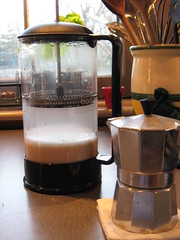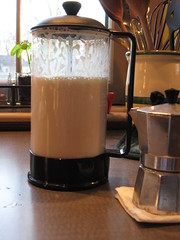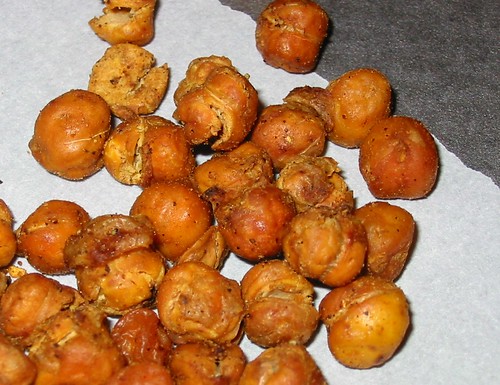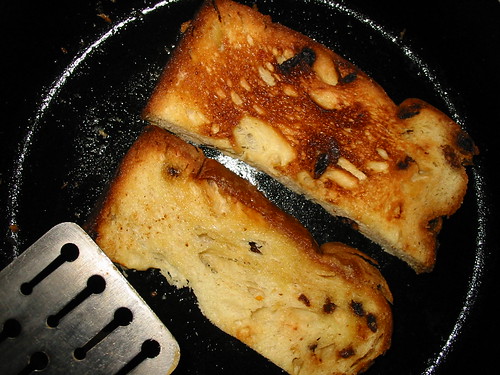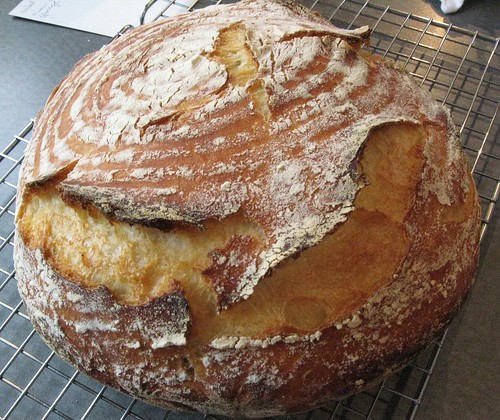
Since the NYTimes video hosted by Mark Bittman (the minimalist) and reported on by various other authors, kneadless bread making has been the niftiest technique in thousands of years, roughly. Although the process was likely discovered many times since bread was in existence, it is becoming more developed and better understood.
The February 2008 issue of Cooks Illustrated disclosed significant process improvements to the sometimes capricious method. It's paid content and a laborious effort, so I can not ethically disclose the intellectual property here. This is entered as an endorsement of the methodology. The article is only two pages. I bought it just for this piece and don't regret it.
Here's my stab at it.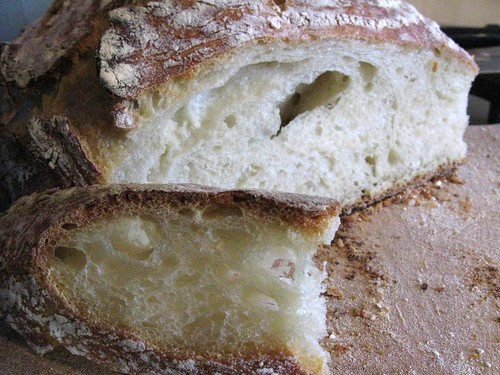
The crumb
It's unfortunate I can't upload an aroma.file.
1.27.2008
Kneadless, all the rage
1.26.2008
Whole Wheat Pasta - Part 2, The Rolling
In part 1 of this adventure, I made the dough for the pasta and placed it in the fridge for 4 days. Upon sitting in the fridge, the dough became noticeably darker but just as moist as when I had placed in to rest.
The first concern of this experiment was the physical properties of this dough. With only half the flour bill made up of unbleached white, would the dough be sturdy enough to hold up to rolling to a 1/32" or so? It did so with flying colors! It was sturdy yet tender (when I tasted a raw noodle). Sorry not enough images to show the rolling itself. To roll out the squat discs, I generously floured the surface and rolled each piece to a rectangle of about 18" x 12". It was approximately as thick as a flax seed; I could feel the bumpiness of them as I rolled. I divided the rectangle with my spackle knife and cut the ribbon shaped noodles one at a time (faster than it sounds) and tossed them on my cutting board in our very low humidity kitchen until dinner (several hours in advance, although they'd be ready to eat immediately).
Freshly cut noodles.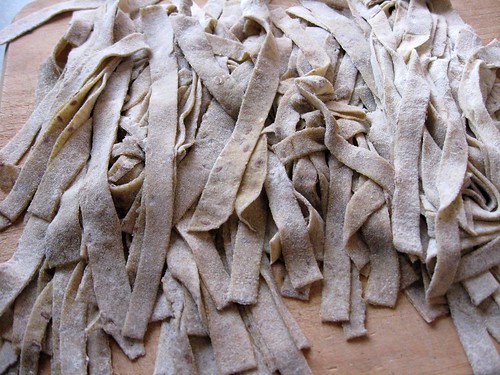
All the noodles drying on my cutting board.
With the composition of the dough just peachy and easy to work with, the final question will be answered tonight. Taste??? We're preparing to eat them in a minimal preparation to highlight the noodle. I'm considering a sparse sauce of brown butter and sage. The raw noodles are pretty tasty. We'll see how the dish comes out. Very exciting.
1.22.2008
Whole Wheat Pasta - Part 1, The Dough
The day before the day before xmas, the wife, kid and I were a mighty ravioli machine. I'd roll pasta, the wife made the cheese filling and she and Frankie filled the pasta, gently sculpting them closed. For some reason, I loved rolling the dough this year. I was in the zone. This flour and eggs product is challenging to prescribe quantitatively. I once tried making pasta dough in a bread machine and destroyed it. It can be tough stuff.
E.g., I start with 2C of flour and 1/2 t salt and add 2 eggs and 2 t olive oil. Forming a well in the middle of the flour, the eggs are beaten lightly and flour is incorporated as much as the beaten eggs will allow to obtain a loose clay-like consistency (this'll make about 1 lb hydrated pasta, ca. 4 servings). Leave the remaining flour incorporation and kneading until the dough gets rolled out.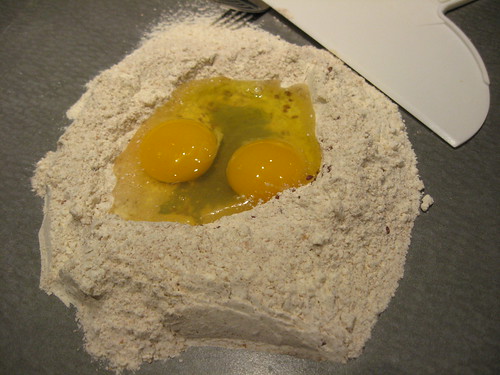
Tonight's experiment stems from our recent conversion to whole wheat pasta (dried). We love it. It has a bit more depth of flavor and the kid likes it as well. I think food science has improved this product immensely in recent years. It's also about 2.5 times the fiber per serving. Win-win.
How about fresh whole wheat pasta? The concept's been stuck in my head since xmas eve. I have a container of flour composed of equal weights spelt, rye and whole wheat flour. I use the mixture in grainy breads. It's handy. 1 C of this grainy mixture was combined with 1 C unbleached white, 1/2 t salt and 1/4 C flax seeds (flax seeds are yummy - too much for pasta? - we'll find out) and mixed. Here's the mixture with a couple eggs broken in to it (plus a squirt of evoo).
I whipped the eggs lightly and slowly incorporated the flour mixture, then folded the soft clay-like lump with my trusty spackle knife until it wasn't too sticky, incorporating as much flour as I needed to keep it from being sticky, but soft. I used another egg on the remainder of the flour. The combined mass was split into 3 balls, flattened and put in the fridge.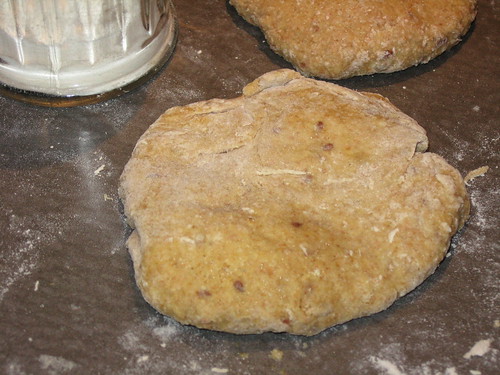
The dough only needs to rest about 30 minutes before rolling, but it's stable for days.
I whipped these up in about 15 minutes with no mechanical equipment. I have pasta rollers and attachments for the Kitchen Aid, etc. I've found the more complicated the setting is to get something done in the kitchen, the more likely I'll never do it.
So, toss some flour on the counter, whip some eggs in the middle and start whisking and kneading.
Next, I roll it out paper thin and cut it into noodles. Stay tuned for the mysterious whole wheat/flax seed pasta.
1.20.2008
French Press Decaf 2% Latte
Mrs. DavesBeer and I spend like we're in a depression (are we in one yet?). Two thousand years in school will do that. So, when the economy really gets shitty, what to do? The frills go, first are the girly coffee drinks. However, I absolutely love a latte once in a while but at greater than $3 a shot, once a month is about all I'll treat myself. How to make one at home without an expensive machine?
A while ago, I noticed a mini press pot that claimed to froth milk. I saw it long ago and the concept stuck in my head. All it could do, if it worked, is aerate a liquid that had surface properties adequate to contain the gas punched into it. To the lab.
I already had my 2nd cup this morning, so I opted for a decaf shot with my moka pot (the cheapo espresso). For a latte, even an instant espresso shot would probably be adequate (parenting kills one's purist tendencies) since it's mostly milk, e.g., Medaglia Doro, is a good instant. Then, I put 2% (lower fat milk has the best surface properties) scalded milk in my french press with the coffee, plunged it , lifting it out of the milk each time. Within several plunges the volume nearly doubled. Voila! Latte that would easily rival your local barrista's.

So, the economy might just tank, but we'll still have our latte.
(Note: images aren't the best because I was fooling with no flash settings, should be better in the future.)
1.17.2008
Dried Beans: Does freshness matter?
I've heard many anecdotes regarding dry beans, e.g., if they're too old, they'll cook up tough, chalky, wrinkly, etc....
Although the complexity of carbohydrates, proteins and residual moisture that comprise a legume is overwhelming on a molecular level, the macroscopic physical properties appear simple. A dried bean simply means it's a fresh bean that's been dehydrated to very low moisture levels (for preservation). It's tough for me to fathom anything can really happen to this system over time ("fresh" dried bean vs "old" dried bean). I read a lot of patent literature in food science (FreePatentsOnline.com) and haven't found any information (yet) regarding the implications on the resulting cooked bean if it's dried recently or long ago.
If you're not already asleep, I figured I'd take a break from hunting through the literature and try an experiment.
I had these OLD garbanzo beans in my cupboard. We love our beans in this house and I did not want to loose these. Buoyed by an NPR story on the dried bean, in which the take home lesson is simmer them slowly for a tender bean. Taking that message seriously, I dumped about a pound of dried ceci beans in a 3.5 L sauce pan, filled it with tap water, brought it to a boil and turned them down to the lowest barely sub-simmer heat for 8 hours (overnight). The water was salted. The next morning, after they cooled I tasted a few. Lovely. Perfect bit of resistance to the bite, not chalky, plump, yummy garbanzos.
I'll keep looking for data to support the claim that dried legumes vary in any way depending on how long ago they were dehydrated. I don't expect to find any. But, I'll keep looking (maybe submit this to Mythbusters or something).
1.13.2008
The Best - So Far
 RePost: Last night I used a type "00" Italian (very finely milled, from KingArthurFlour.com) flour in my baguette recipe and it wasn't as good. I will be trying it a few more times before returning to Montana Sapphire as well as using it for a couple pizzas, but the early results favor Montana Sapphire. The original post follows.
RePost: Last night I used a type "00" Italian (very finely milled, from KingArthurFlour.com) flour in my baguette recipe and it wasn't as good. I will be trying it a few more times before returning to Montana Sapphire as well as using it for a couple pizzas, but the early results favor Montana Sapphire. The original post follows.
Faithful readers of the weber_cam know I am absolutely obsessed about flour. I buy a bag and immediately put it through a "use" test. A use test is a euphemism. It means you don't know enough about the specifications of the material to adequately know if it will work in your application - so you use it and see if it's ok. Too many cookbooks blindly preach more is better when it comes to protein content in flour. Ultimately, it depends on your application. Flour's complicated and there are many more significant specs (ash, ascorbic acid additive, bromate or not, etc., ) that are crucial to the final product. Also, it's good to find a flour that will be constant over time. That's why I prefer large manufacturer flours. Small mills have greater variability.
Montana Sapphire unbleached white flour is my current favorite. It's all-purpose with a protein content of 10% w/w and it performs extremely well in my use test. My test recipe is a straight dough baguette:
water, 200g
flour, 300 g
rapid rise yeast, 2.25 t
salt, 5 grams
butter (currently olive oil), 4 grams
3 rises, baked at 425 for 30 minutes. It's been a stellar performer. And, it's available at Giant-Eagle in 5, 10 and 25 lb bags.
1.08.2008
Spiced Chickpeas
My sister (Frankie's Auntie Denise) sent me a recipe for spiced chickpeas, a healthy snackfood. I changed the recipe based on what was in my cupboard and tastes and let it rip. So, a drained 19 oz. can of chickpeas is added to a large bowl. To this is added 1/2 T olive oil, 1T garam masala (a mixture I made a long time ago), 1T ground cumin, 1t salt, and some paprika. I swirled all the ingredients and dumped it in a short rimmed baking pan. I baked these at 300 (convection, 350 conventional) for periods of 15 minutes, a total of 1 hour.
I think they got slightly over done. At 30 minutes, they were still too moist. I suspect 45 minutes would've been the trick. They're still tasty, but I'll try again for a shorter baking time.
Mmmm, snackfood for today. Thanks Denise!
1.07.2008
Pizza Friday
A food tradition seems to be developing in our house for Friday night pizzas. I think it's because by Friday, we're exhausted from the week and Pizza's the easiest thing we can get to the table.
Frankie's been pushing out dough since she was about 18 months and she would pound out the focaccia. Although a true Pizzaioli would never use a rolling pin, but Frankie prefers one for now. Eventually, I hope she'll lose this crutch and start pushing and tossing the dough to a nice round.
Soon, when I can track some down, we'll be investigating tipo 00 flour for this effort. Details to come.
1.06.2008
1.02.2008
baguettes
Some bread to bring to a splendid New Year's lunch. Soon, I'll be immersed in Italian tipo 00 flour. Carfagna's market has it. I'm hoping to score some before the weekend.
Keep you posted on comparative results of this flour compared to my regular Montana Sapphire.
{Some notes for myself on these loaves:
10 g olive oil/1000 g dough, post baking weight, 850 g (this run)
20 g olive oil/1000 g dough; post baking weight, 900 g;
5 g olive oil/1000 g dough; post baking weight 800 g}
